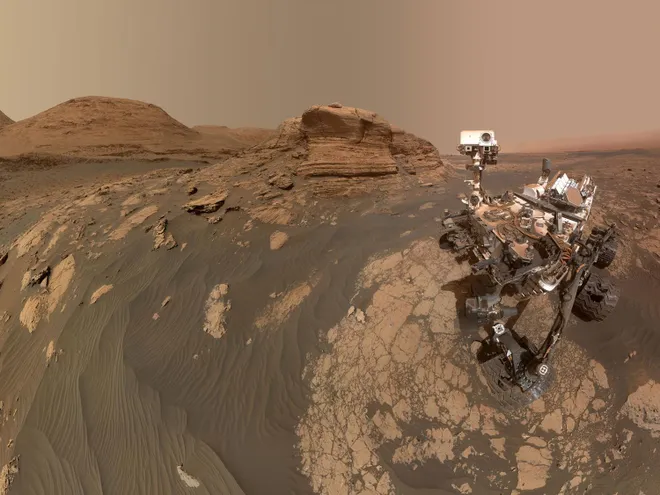Researchers find signs of rivers on Mars, a potential indicator of ancient life
Mars has long served as inspiration to many a science fiction writer in search of a home planet for their imagined extraterrestrials.
But could the terrestrial red planet ever have actually been home to Martians?
New research from a team of scientists at Penn State who analyzed Curiosity rover data found that Mars could once have been teeming with flowing water: the bedrock of life. In a study published in Geophysical Research Letters, the researchers determined that many of the craters covering Mars could have once been habitable rivers.
“Mars could have had far more rivers than previously believed, which certainly paints a more optimistic view of ancient life on Mars,” Penn State geosciences professor Benjamin Cardenas, the study's lead author, said in a statement this week. “It offers a vision of Mars where most of the planet once had the right conditions for life.”

Ancient cosmic flash:A radio burst that traveled 8 billion years to reach Earth is the farthest ever detected.
NASA has future interest in Mars
The findings are among the latest breakthroughs amid heightened interest in studying Mars.
Evidence has of late been mounting that life may have once existed on the rocky, inhospitable planet, which NASA astronauts have aspirations of one day soon visiting.
Findings from NASA's Perseverance rover led researchers to conclude in a July study that organic molecules, a potential indicator of life, were present in rocks where a lake long ago existed on Mars. However, the researchers noted that evidence of such molecules is not proof of life past or present on Mars, and that non-biological processes remain a more likely explanation.
“Mars is exciting, and still may have signs of life,” Andrew Steele, a Carnegie Institution staff scientist who has investigated the Mars rock, said in a statement at the time. “But it is also teaching us about how the building blocks of life can form.”
NASA has sent a host of remotely-operated landers, orbiters and rovers to study Mars and bring back geologic samples. While no humans have set foot on the planet, that could change.
NASA has resumed lunar missions for the first time in decades with its Artemis program and plans in 2025 to send astronauts back to the Moon for the first time since 1972. Once there, NASA hopes to establish a permanent human presence on and around the moon to serve as a base of operations of sorts for future missions to Mars.
In September, NASA successfully tested a breathing device called MOXIE (Mars Oxygen In-Situ Resource Utilization Experiment) to produce oxygen for astronauts during future Mars missions.

Study:Asteroid known as Polyhymnia may contain 'superheavy' elements unknown to humans
Study: Mars landscape not 'frozen in time'
While evidence for rivers on Mars has been known since the Mariner 9 mission, which became the first spacecraft to orbit Mars after launching in 1971, the recent study suggests that rivers were more widespread than previously believed.
The study was the first to map the erosion of ancient Martian soil by training a computer model on a combination of satellite data, Curiosity images and 25-year-old scans of Earth's own rock deposits. Researchers said that the 3D scans from beneath the Gulf of Mexico seafloor provided an ideal benchmark to which to compare Mars stratigraphy — layers of rock deposited over millions of years.
Researchers simulated Mars-like erosion over millennia using the Earth scans to discover that common crater formations could be explained as the remnants of ancient riverbeds. The analysis is the first time that data of erosional landforms collected by Curiosity at Mars' Gale crater have been interpreted as possible river deposits, according to the researchers.
Because rivers are such an integral component for life on Earth, researchers theorized in the study that their findings, if accurate, could serve as evidence of the past existence of ancient extraterrestrial organisms.
The findings further suggest that more undiscovered river deposits could be found elsewhere on the planet and that a large chunk of Mars could have been built by rivers during a habitable period of the planet's history, the researchers claim.
As the Curiosity rover continues to capture evidence of abundant water on an otherwise arid planet, NASA has said that other possible future places to look for signs of life on Mars include sites where water collected underground, once forming a system of subsurface lakes.
“We see signs of this all over the planet," Cardenas said. "What we see on Mars today is the remnants of an active geologic history, not some landscape frozen in time.”
Eric Lagatta covers breaking and trending news for USA TODAY. Reach him at elagatta@gannett.com

Disclaimer: The copyright of this article belongs to the original author. Reposting this article is solely for the purpose of information dissemination and does not constitute any investment advice. If there is any infringement, please contact us immediately. We will make corrections or deletions as necessary. Thank you.



